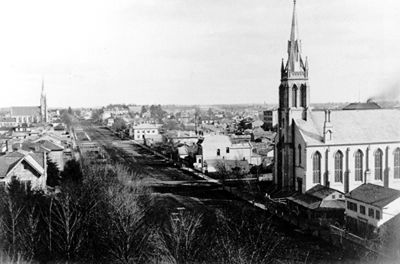|
History of London Ontario
244 Hyman St, London, Ontario N6A 1H5

London is a city in Southwestern Ontario,
Canada along the Quebec City–Windsor Corridor. The city has a population
of 383,822 according to the 2016 Canadian census. London is at the
confluence of the Thames River, approximately halfway between Toronto,
Ontario and Detroit, Michigan. The City of London is a separated
municipality, politically separate from Middlesex County, though it
remains the county seat.
London and the Thames were named in 1793 by John Graves Simcoe, who
proposed the site for the capital of Upper Canada. The first European
settlement was between 1801 and 1804 by Peter Hagerman.[4] The village was
founded in 1826 and incorporated in 1855. Since then, London has grown to
be the largest Southwestern Ontario municipality and Canada's 11th largest
metropolitan area, having annexed many of the smaller communities that
surrounded it.
London is a regional centre of health care and education, being home to
the University of Western Ontario, Fanshawe College, and several
hospitals. The city hosts a number of musical and artistic exhibits and
festivals, which contribute to its tourism industry, but its economic
activity is centred on education, medical research, insurance, and
information technology. London's university and hospitals are among its
top ten employers. London lies at the junction of Highway 401 and 402,
connecting it to Toronto, Windsor, and Sarnia. It also has an
international airport, train and bus station.
|
Charles Smith ("C.S.") Hyman, PC (August 31, 1854 – October 8, 1926)
was a Canadian businessman, and notable politician and sportsman. He
was a popular Tennis player and won a record 5 times Canadian Open
until broken by Ivan Lendl with 6 trophies.
Born in London, Canada West, the son of Ellis Walton Hyman, a tanner
and entrepreneur, and Annie Maria Niles, he was educated at Hellmuth
Academy in London and then started a shoe factory with his father in
1874. In 1876, he married Elizabeth Birrell, and two years they had
Idlewyld mansion built,[1] which is now an inn. Hyman was president
of the London Board of Trade from 1881 to 1882. In 1916 he built a
summer estate in Port Stanley Ontario on the shore of Lake Erie. He
was also a tannery owner.[2]
Hyman was elected to London city council in 1882 and was mayor in
1884. He first ran as a Liberal candidate against John Carling for
the Canadian House of Commons in the 1887 election for the riding of
London and was defeated.
Hyman ran again in 1891 and was elected but the election was
declared void and he was defeated in the resulting 1892 by-election.
After losing again in 1896, he was elected in 1900 and was
re-elected in 1904. From 1904 to 1905, he was a Minister without
Portfolio. From 1905 to 1907, he was the Minister of Public Works.
He resigned in 1907.
Hyman was an early Canadian tennis champion, capturing the national
tennis championship (which has since evolved into the current Rogers
Cup) 5 times in singles - for 1884, and for each year from 1886
through 1889. (Only Ivan Lendl surpassed this winning 6 titles from
1980-1989.) Hyman also captured two doubles titles, the 1886 final
partnering I.F. Hellmuth, and the 1889 final playing alongside R.S.
Wood. (No one has ever won a total of seven titles.)
Hyman was also an early captain of the Canadian national cricket
team, quite possibly when on its 1887 England Tour. Hyman is said to
have introduced the game bridge to Canada. |